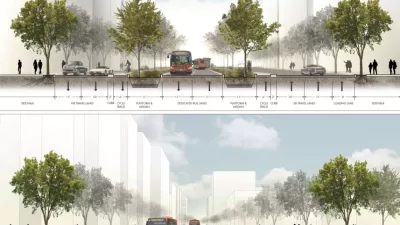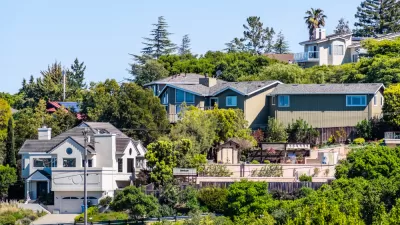Architects and planners have to work together, as everyone on both sides of the equation knows. Even though the fields often speak the same language, there still seem to be many moments and ideas lost in translation.

"Local architects love to complain about San Francisco’s Planning Department, how the latter supposedly thwarts the formers’ efforts to add dynamic new buildings to the landscape," writes John King, in news that won't come as surprise to Planetizen readers.
The reason the San Francisco Chronicle's urban design critic is writing about the history of antipathy between the two related professional fields, however, is that one of San Francisco's best designers has gone on the record with a fairly disparging diatribe regarding planning and planners in a new book by Michael Webb, titled Building Community: New Apartment Architecture .
In the book, Stanley Saitowitz tells Webb of his frustrations as an architect with city planners: "Far too much of our effort goes into explaining what we are doing….The bureaucracy is obstructive, and committee-type negotiations tend to make the buildings worse, not better."
More of Saitowitz's comments are included in the article, especially focusing on tensions between contemporary design decisions and a preservationist approach to new building (those tensions will surely be familiar in cities other than San Francisco).
The comments have provoked a notable response from San Francisco's planning director, John Rahaim, who says: "Most of Stanley’s buildings have been built pretty much as he proposed them to staff. To say otherwise is ridiculous."
Rahaim also has more to say, but King also has the final word about whether these kinds of debates will ever end in San Francisco (spoiler alert: it's not likely).
FULL STORY: Architect calls SF planners “obstructive.” Spoiler alert: they’re ticked

Planetizen Federal Action Tracker
A weekly monitor of how Trump’s orders and actions are impacting planners and planning in America.

San Francisco's School District Spent $105M To Build Affordable Housing for Teachers — And That's Just the Beginning
SFUSD joins a growing list of school districts using their land holdings to address housing affordability challenges faced by their own employees.

The Tiny, Adorable $7,000 Car Turning Japan Onto EVs
The single seat Mibot charges from a regular plug as quickly as an iPad, and is about half the price of an average EV.

Seattle's Plan for Adopting Driverless Cars
Equity, safety, accessibility and affordability are front of mind as the city prepares for robotaxis and other autonomous vehicles.

As Trump Phases Out FEMA, Is It Time to Flee the Floodplains?
With less federal funding available for disaster relief efforts, the need to relocate at-risk communities is more urgent than ever.

With Protected Lanes, 460% More People Commute by Bike
For those needing more ammo, more data proving what we already knew is here.
Urban Design for Planners 1: Software Tools
This six-course series explores essential urban design concepts using open source software and equips planners with the tools they need to participate fully in the urban design process.
Planning for Universal Design
Learn the tools for implementing Universal Design in planning regulations.
Smith Gee Studio
City of Charlotte
City of Camden Redevelopment Agency
City of Astoria
Transportation Research & Education Center (TREC) at Portland State University
US High Speed Rail Association
City of Camden Redevelopment Agency
Municipality of Princeton (NJ)





























